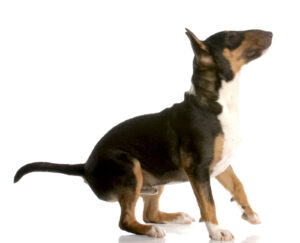Barks Blog
Four on the Floor
By Donna Savoie

Who doesn’t LOVE a puppy? And it is wonderful when puppies LOVE their owners’ guests. But it is also important to start teaching puppies not to jump up on guests sooner rather than later.
Guests inevitably say “I don’t mind” whilst petting an exuberant jumping puppy but this strongly reinforces the jumping behavior at a very early age. Jumping up can be especially problematic later when the dog is fully-grown.
Puppy Training Protocol
The following training protocol will help the owner manage both the puppy and guest, and successfully teach the puppy that all good things happen to those who keep four on the floor.
By using kibble, treats or other types of food or toys, owners can successfully teach their puppy to move away from a person or people who are entering the home. This gives owners time to manage the environment and train the puppy to not jump on people while simultaneously training him to pay attention to them.
Owners can use ‘move away’ training any time they want to encourage their pup to move away from another person to prevent jumping and to reinforce four on the floor. Using the following directions, guests coming into the home will no longer be jumped on as the owner tosses food or toys to encourage the puppy to move away from them. The owner will also successfully prevent the guest from rewarding any jumping behavior.
This technique starts out using a lure and it successfully teaches the puppy to keep four on the floor, to move the other way and that good things happen when people enter the house. At the same time, the puppy learns that fun games happen when guests come.
Caveat: it is necessary to use a toy or treat that is of a “higher value” than that of the guests. So if the puppy is über friendly and absolutely delighted that guests have come to visit, owners may need to toss a very high-value food such as hot dogs or even pork roast, or perhaps the pup’s very favorite ball or tug toy. They will need to be prepared to toss more than one time, as it may take the puppy several repetitions of scurrying away and returning to them before calming down.
If there is no food or toy that is more enticing to the puppy than guests, owners can use an x-pen to prevent the puppy from getting to the guest, thus making the owners and everything that is fabulous about them the only thing available to him.
Four on the Floor: How It’s Done
-
- Be prepared! Does the owner know that guests are coming? The treats should be prepared and stashed in a convenient location.
- If the owners frequently have guests coming to the home unannounced, they will need to have food or toys available at the entrance door at all times, secretly stashed. Training happens through consistency.
- Have a goal. Generally the goal is simply for the puppy to not jump on the guest. However, over time the owner can increase the criteria.
- When the guest knocks on the door the puppy will probably bark and get excited. Owners need to bring the puppy with them to the door and, before opening the door, toss yummy treats or toys away from the door while all four feet are still on the floor. Owners should try to remain calm and not get the puppy more aroused with “who’s here!” or “let’s go answer the door!”
- As the puppy is scurrying around to find the treats or toys, the owner can open the door and allow the guest in, instructing him or her not to speak to or acknowledge the puppy. When the puppy turns and notices that someone has entered the home, the owner should call his name or make some enticing sounds to get his attention and immediately toss treats again. But it has to be fast. The goal is to avoid the puppy getting to the guest and jumping up. The puppy should then go scurrying away again to find more treats or toys.
- Repeat this procedure several times until the puppy is scurrying around and then returning to the owner fluidly. The owner is the bearer of treats and toys and therefore the puppy should return to them.
- Once the puppy is reliably returning to the owner, it is time to ask for a sit.
- Once the puppy sits, the owner can toss again.
- Simultaneously, the owner should ask the guest to ignore the pup. No petting the puppy, no talking to the puppy, no engaging the puppy at all. This helps make the owner the bearer of all good things, including love and attention.
- Once the puppy is not super excited that guests are in the home, the owner can instruct the guest how to interact with the pup.
- As time goes on the owner will need to toss fewer treats/toys and less often and eventually not at all.
- As the owner becomes proficient and coordinated with managing the door, the treats, etc., they should be animated and consistent with the hand signal as they toss, so that the puppy learns that “that” hand signal means to go “that” way. Eventually the owner will not need treats, the puppy will learn the hand signal to move away.
Practice makes perfect!
This article was first published in BARKS from the Guild, January 2015, pp.24-25.
About the Author
Donna D. Savoie CDBC CPDT-KA CBATI ABCDT is the owner and president of Pack of Paws Dog Training LLC in Southbridge, MA.
